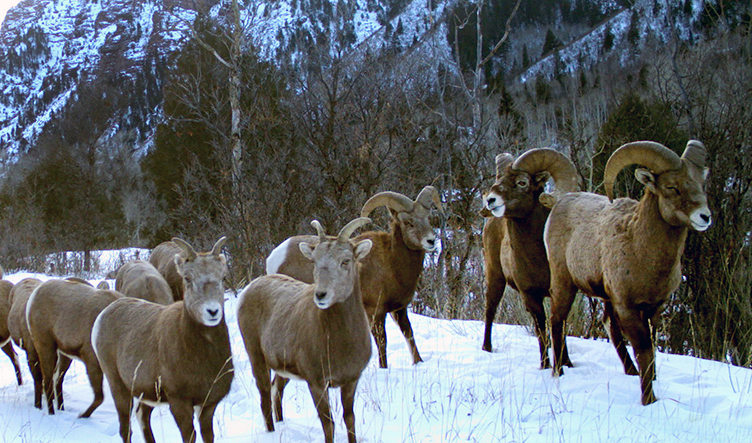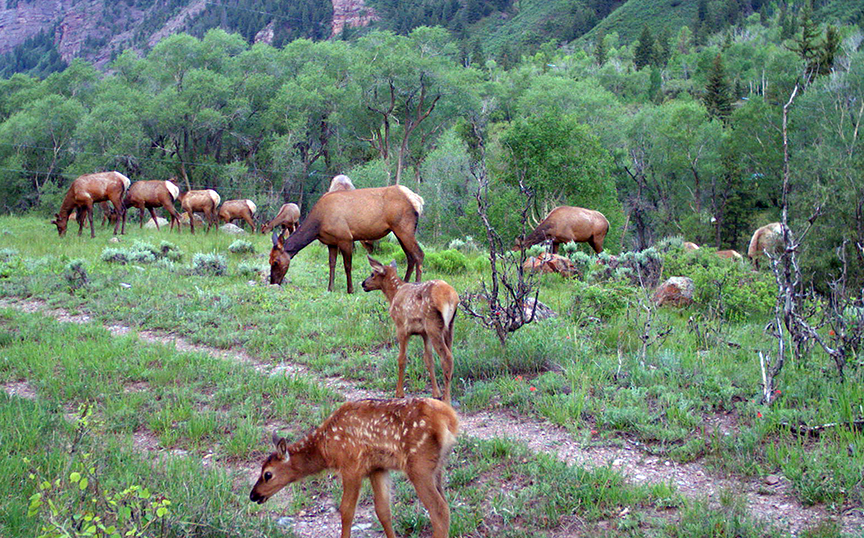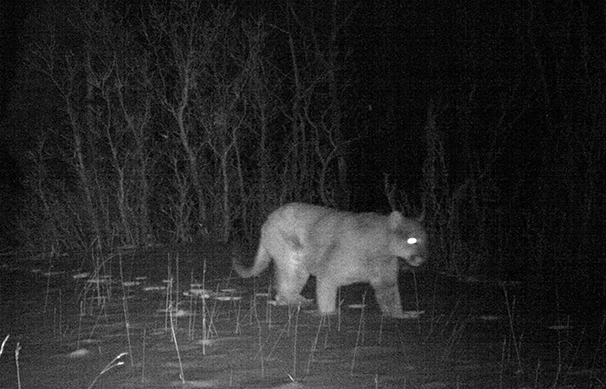A tally of creatures, great and small, at Filoha Meadows

Bighorn sheep at Filoha Meadows in early spring.
With a 9-month, annual closure to human activity and limited visitor access when it is open, Filoha Meadows Nature Preserve really is about nature.
An array of cameras watching the property for the winter of 2022-’23 and close inspection of what was actually on the ground in summer 2022 – tools of the trade for a wildlife biologist – confirmed that Filoha continues to serve as a sanctuary for creatures great and small. A draft report, prepared by Colorado Wildlife Sciences (CWS) of Basalt, summarizes the findings.
Wildlife monitoring in 2022 showed a marked uptick in signs of bighorn sheep, elk and deer on the open space, compared to 2018 monitoring, but the increase may be attributable to environmental variations such as snowpack rather than an actual increase in abundance. A notable increase in species diversity was also documented in 2022, though additional monitoring is needed to verify a trend in the number and variety of the animals that use Filoha Meadows.
In all, 13 mammal species have been detected at Filoha, including three that were detected for the first time in 2022 – long-tailed weasel, moose and Pacific marten. The camera array picked up 4 to 5 different black bears, including a very large, mature specimen, as well as one tiny deer mouse, and plenty of critters in between. An avian survey conducted in 2020 documented 32 bird species at Filoha.
Two species that are neither mammal nor bird were also seen at Filoha for the first time in 2022 – two bull snakes and two monarch butterfly caterpillars (the monarch butterfly is a candidate for endangered or threatened status).
Among Colorado’s threatened and endangered species, one – Townsend’s big-eared bat – is active at Filoha Meadows, fluttering through the night sky in search of insects, though the bats roost nearby, on the White River National Forest. On the Forest Service’s Sensitive Species list are two animals known to exist at Filoha – Pacific marten and Rocky Mountain bighorn sheep. In addition, 19 bird species that have special conservation status or are known to be in decline have been detected at Filoha Meadows.
Both elk and bighorn sheep depend on Filoha Meadows, according to CWS. “The property provides some of the most important winter and transition habitat for bighorn sheep in the Crystal River Valley,” noted its draft report on the 2022 monitoring field season. “Given the above-average snowpack of 2022-’23, the heavy winter use of Filoha by sheep is indicative of the importance of the property to sheep in normal to severe winters.”
Thermal activity at Filoha helps keep forage accessible to sheep in even the worst winters, while the adjacent steep slopes and cliffs offer escape from predators, namely mountain lions.
A vegetation treatment scheduled in August/September at Filoha and the adjacent national forest will clear areas of piñon-juniper that are encroaching into grassy areas in order to improve sightlines and escape routes for sheep. Bighorns rely on keen vision to detect predators, and on rapid mobility on steep terrain as the principal means of avoiding them.
Lion activity has been documented by Pitkin County Open Space and Trails through its wildlife cameras, both at Filoha Meadows and in the national forest north of Filoha’s border (including four lions together – likely a female with three juvenile offspring in tow).
The winter-long camera monitoring by CWS in 2022-’23 indicated elk are likely present at Filoha Meadows throughout the year. While elk calving at Filoha is suspected, elk are clearly using the property for rearing their young, the CWS draft report concluded.
Open Space and Trails regularly documents young, spotted elk calves on the property in spring and early summer, with its wildlife camera.
Among CWS’ recommendations are continued wildlife and avian surveys, continuation of limited public access to Filoha Meadows and maintaining the dog prohibition that is in place there.
Closing off some aspen stands to elk to evaluate browsing pressure at Filoha should be considered, according to CWS. The report endorsed this year’s planned vegetation thinning at the property and recommended protection of Filoha’s stand of milkweed – a plant that is crucial in the lifecycle of the monarch butterfly.
Wildlife monitoring at Filoha Meadows Nature Preserve will help inform an upcoming update to the Filoha Meadows Nature Preserve Management Plan. Find out more about this planning process.
The Filoha Meadows Nature Preserve Annual Wildlife Monitoring Report – 2022 Field Season will be posted to pitkinoutside.org/ecofinder/ once it is in final form.
– By Pitkin County Open Space and Trails

Elk rear their calves at Filoha Meadows.

A mountain lion on the prowl at Filoha Meadows.
